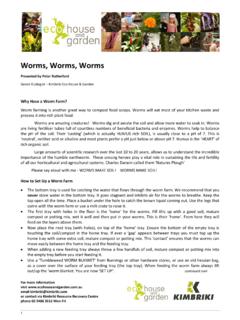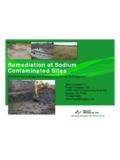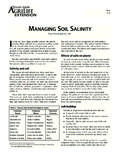Transcription of Worm Farming - Fact Sheet
1 worm Farming - fact Sheet What is a worm farm? A worm farm is a community of worms established as a method of recycling food and some other organic wastes into natural fertiliser products. A worm farm can be purchased or home-made and is ideal for those with small gardens, courtyards or balconies, or for a school or office environment. Why start a worm farm? worm Farming allows us to recycle our food scraps and significantly reduce the amount of organic waste sent to worm farms recycle your landfill as part of our everyday rubbish. By reducing organic food waste into ideal natural waste to landfill we can reduce the potential for landfills fertilisers to improve the to create liquid leachate' which can pollute our streams, health of your garden . oceans and underground water, and reduce the production of methane gas which is a powerful greenhouse gas. A worm farm produces vermicast, a soil-like material, and a juice' which are both nutrient rich and make ideal natural fertilisers to improve the health of the plants in your garden.
2 Establishing and maintaining a worm farm is great fun and an excellent way to educate children about our natural world while touching on a myriad of topics including maths, spelling (hermaphrodite), art, biology and soil chemistry. In addition, managing a worm farm may also provide your children, or students, with a sense of responsibility both for their own actions and the world we live in. How to set up a worm farm The bottom tray is used for catching water that comes through the worm farm. It is recommended you do not use the tap provided. Just put a bucket under the hole to catch the brown liquid coming out. Use the legs which come with the worm farm or use a milk crate to raise it. The first tray with holes in the floor is the home base for the worms. Fill this up with good compost, wet it well and then put in your worms. This is their home. From here they will feed on the layers above them. Now place the next tray (with holes), on top of the home tray.
3 Ensure the bottom of the empty tray is touching the soil/compost in the home tray. If ever a gap appears between trays you must top up the home tray with some extra compost or potting mix. This contact ensures that the worms can move easily between the home tray and the feeding tray. When adding a new feeding tray always get a few handfuls of soil or mature compost or potting mix and throw in to the empty tray (once in position) to join up the new tray, with the food in the current tray. For the final step, get one of the new Tumbleweed worm Blankets from Bunnings or other hardware, or use an old Hessian bag, as a cover over the top of all fresh food scraps. When feeding the worm farm always lift out/up the worm blanket. For more information visit , email us at or contact us via the Kimbriki Resource Recovery Centre on 02 9486 3512 (Tuesday, Wednesday and Friday). fact Sheet by Peter Rutherford, Ecologist and Senior Eco Gardener - Kimbriki Eco House and Garden.
4 worm Farming - fact Sheet How to manage a worm farm Ensure that excess water can drain freely from the worm bedding. Leave the tap open all the time (or better still, remove the tap completely) with a bucket underneath to collect the valuable liquid. Lift up the worm blanket and place food scraps on up to half (max) of the surface of feed tray, sprinkle with some soil or potting mix. Feed with a high variety/diversity of food scraps. The more chopped up the food scraps, the quicker it will be converted by the microbes and worms. Some people actually blend their food scraps and then feed this blend to the worms. This allows you to put a greater quantity of food scraps through the worm farm. Lay down the worm blanket again, put on the lid and place a brick or something weighty on lid to hold it down. Once each week, flood the farm from the top with water until fresh worm juice is running out the bottom hole into your bucket.
5 This will also ensure that you will get a regular supply of worm juice to spray and water onto your plants and living garden soil. Empty out the worm juice bucket every week this will stop it smelling and will stop mosquitoes breeding in there. If mossies do breed in there then tip 20 to 50ml of your vegetable cooking oil onto the surface of the water each time it refills. How much food? This will depend on how many worms are in your farm and the daily temperature. Worms like a soil temp of about 20 to 25 C. If it is too hot or too cold they will slow down and eat less. One of the biggest mistakes people make with worm farms is overfeeding. If you are overfeeding and the worms can't eat it all, it will start to smell bad. If this happens, get a small garden tool or stick, and scratch up the tray you are feeding into, add a bit more soil and handful of dolomite and do not feed for a few days or even a week. Every time you feed your worms, sprinkle a few handfuls of soil on top of the food.
6 This gives the worms some grit, which they use in their gizzard, to grind the food up. Keep the surface covered with a Tumbleweed worm Blanket or a hessian sack. Do not use thick newspaper over the surface as this can limit aeration to the oxygen breathing worms. Keep the system moist at all times. Once a week get a bucket (4-6 litres) of fresh water and pour over the entire surface of the food collecting tray until tea is running out the open tap. Leave tap open 24/7. Take off Tumbleweed worm Blanket before you pour on the water. Clean out the bottom liquid collection tray at least once per month. Sprinkle a handful of dolomite lime (or wood ash), once a month, into the food you are adding (or only every two months if worm farm is going well and very active). Optional: Sprinkle a handful of Basalt Rock Dust once a month into the food you are adding. Good rock dust can add 70, or more, different minerals into the system and then into you, when you eat the plants grown using some of the wonderful worm castings.
7 Rock Dust can also be added to your vegetable and herb gardens directly about a handful per square metre every 1 or 2 years. For more information visit , email us at or contact us via the Kimbriki Resource Recovery Centre on 02 9486 3512 (Tuesday, Wednesday and Friday). fact Sheet by Peter Rutherford, Ecologist and Senior Eco Gardener - Kimbriki Eco House and Garden. worm Farming - fact Sheet worm facts Worms are soil makers and are a key part of healthy soils. Looking after the worm communities in our worm farms assists us to improve the soils in our gardens and to encourage a healthy natural population of worms in this environment. Worms eat organic matter and turn it into vermicast, a type of humus - the richest and most important part of all soils. Vermicast has a high level of microbial activity, and when added to soil, increases the microbial activity of the soil. This assists plants to strengthen their immune systems.
8 Worms in our soils dig holes that allow the rainwater to move deeper into the soil, down where the roots of plants are, ensuring water is getting to the place it is needed most. worm holes allow soils to breathe ensuring plants are healthy and vibrant. Worms increase the water holding capacity of the soil. Worms increase the amount of minerals available to plants in the soil. To learn more about worm Farming come along to one of Kimbriki Eco House and Garden's The Wonderful World of Worms workshops. For more information visit , email us at or contact us via the Kimbriki Resource Recovery Centre on 02 9486 3512 (Tuesday, Wednesday and Friday). fact Sheet by Peter Rutherford, Ecologist and Senior Eco Gardener - Kimbriki Eco House and Garden.








